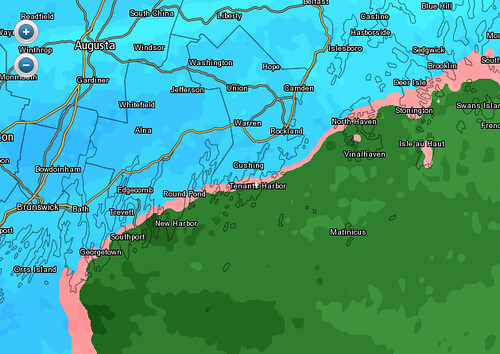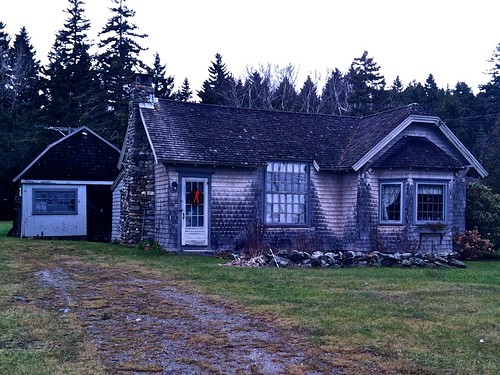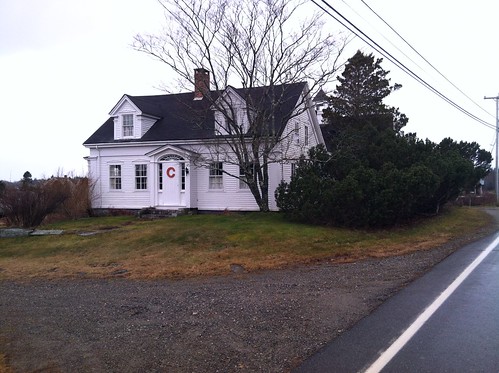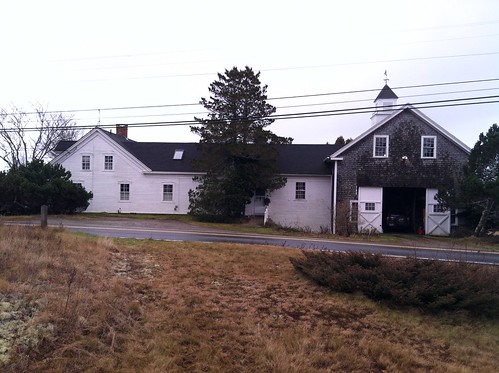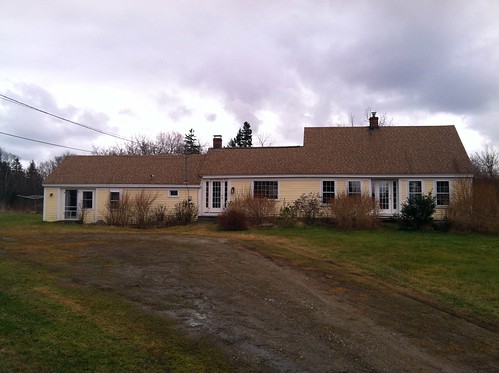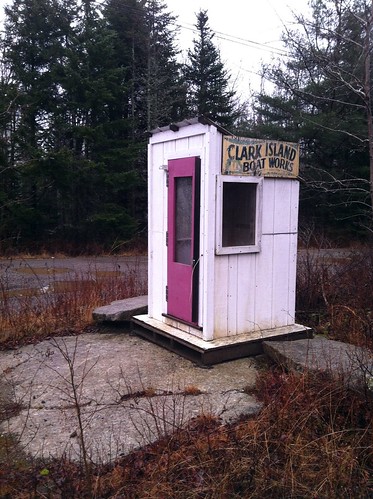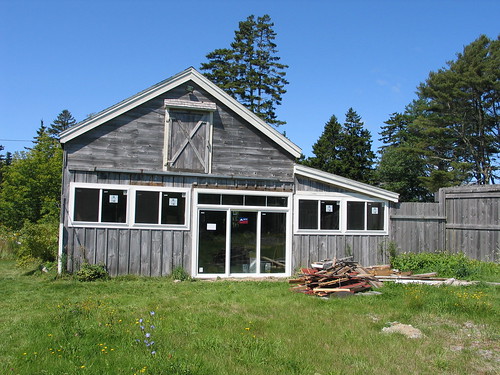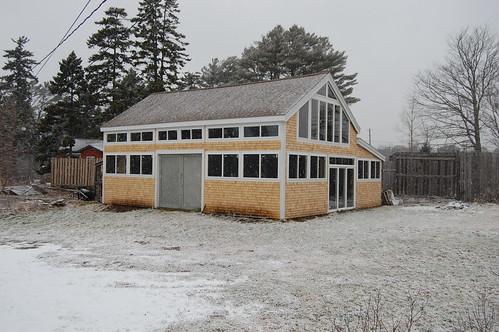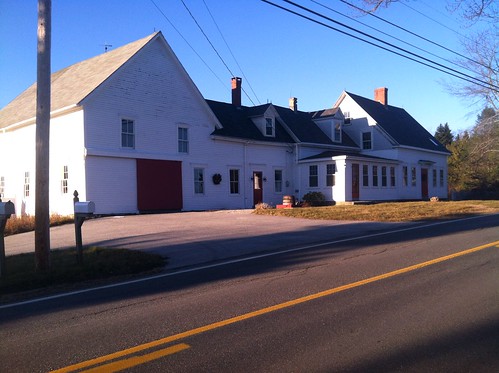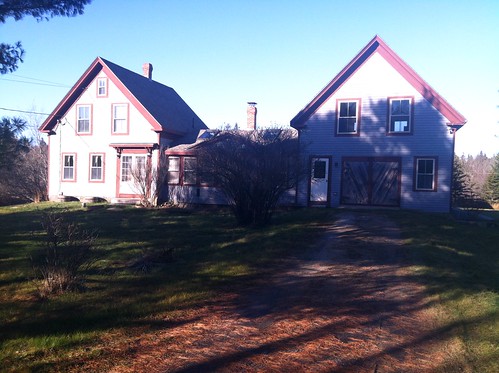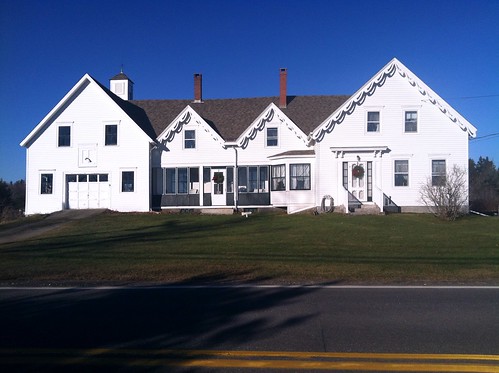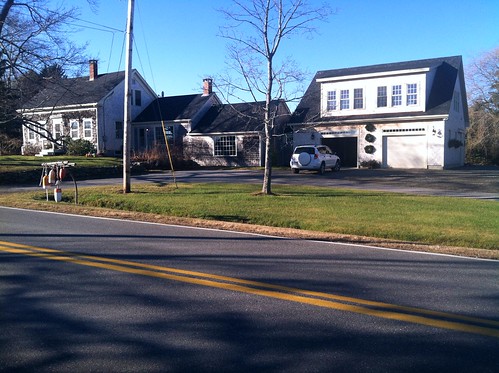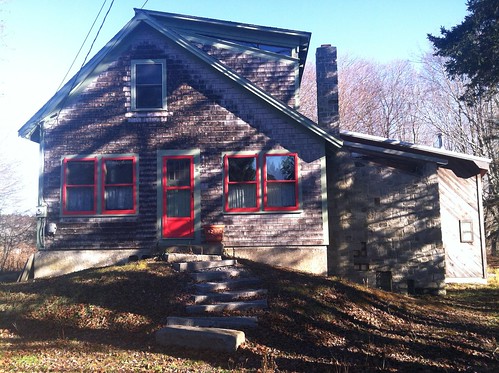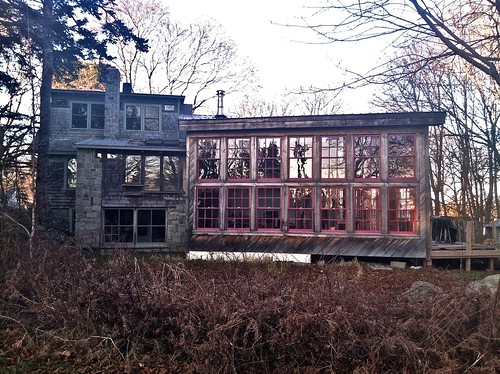December 28, 2012
sez Dave Weinberger
"...everything is interesting if observed at the right level of detail..." (in a posting about indexers, itself redolent of the unmissable)
December 27, 2012
December 25, 2012
vernacular architecture of a sort
David Malki captures an essence that I should have thought of myself (given that I'm thinking about how people construct the spaces they live in --and given that we now have a camera that can capture stuff in very low light). Not that there's so very much Xmas decorating of this sort in the Midcoast, but I ought to collect some examples of what there is.

(he says permission to embed is granted)
December 22, 2012
on a walk in the rain
within a kilometer of home, along Route 131 in Martinsville:
Pointed Fir, alluding to Sarah Orne Jewett's Country of the Pointed Firs, written in and about Martinsville ["Dunnet Landing"] ca. 1896 (Jewett rented the schoolhouse building, next door to Pointed Fir -see text of the novella)
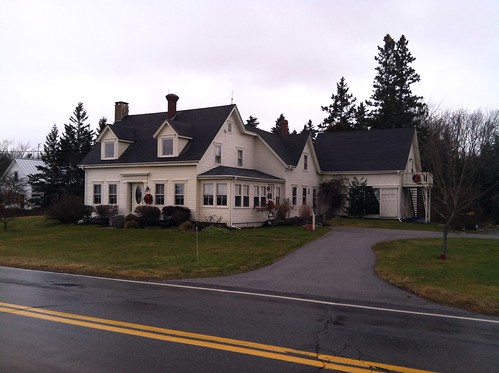
not the color I'd have chosen:
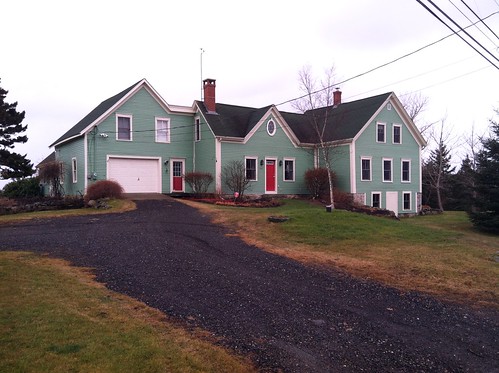
close to home
A variant of the house-connector-barn, various pieces renovated at different times. The old house (ca. 1850) is to the right, 4-over-4 with a center chimney and minimal basement. The middle piece has been the kitchen for many years (and might have been added ca. 1900 or so, to judge by construction details), and the shed on the left was added to the living space only 40 or so years ago.
endangered species
What with declining birthrates and the effects of global warming, purpose-built units like this schoolbus shelter are now rare in the Midcoast landscape:
December 16, 2012
The barn
Thinking about my own efforts, the 2008 barn renovation stands out:
(I'll put up other shots as I find them in the archives)
A clutch of probably-relevant books in my library
these are directly relevant to the project:
Identifying American Architecture: A Pictorial Guide to Styles and Terms, 1600-1945 / John J. G. Blumenson
Big House, Little House, Back House Barn: The Connected Farm Buildings of New England / Thomas C. Hubka
Discovering The Vernacular Landscape / John Brinckerhoff Jackson
A Field Guide to American Houses / Virginia McAlester
Field Guide to New England Barns and Farm Buildings (Library of New England) / Thomas Durant Visser
these have been with me for years, and I recognize them as broadly influential:
Shelter (1st Edition) / Lloyd Kahn
Shelter II / Lloyd Kahn
Modern Architecture and Design: An Alternative History / Bill Risebero
The Story of Western Architecture, 3rd Edition / Bill Risebero
Architecture Without Architects: A Short Introduction to Non-Pedigreed Architecture / Bernard Rudofsky
Looking Around: A Journey Through Architecture / Witold Rybczynski
A stretch of Glenmere Road
In March 2007 I snapshotted all the houses along about a mile of one of the back roads that I walk frequently. One question to ask: how much have things changed, or not, in five years? Here's the set.
Vernacular Architecture of Midcoast Maine
Here's a bit of text I wrote a couple of days ago, while walking to the post office:
A local landscape is a palimpsest of building history, and any wall or roof or chimney or porch or doorway is a product of choices make by somebody, or a succession of somebodies. Untangling the history is no simple task, even for a single property, but general patterns do emerge if one is attentive to local variation, and local knowledge can be eloquent if the investigator is patient.The work of architects and builders is 'vernacular' insofar as it incorporates local tastes and predilections, and departs from the vernacular to the degree that its design and particulars use other (exogenous, not-popular) design items and materials. The vernacular is 'popular' in the sense that it's how things are done in local tradition and practise.
Architectural history is a fruitful arena for the skills and tools of an anthropologist: there are observables and objective facts, but also plenty of room for the values and notions and delusions of the people who inhabit the architecture. People build houses with materials and tools and ideas congenial to climate and locality. Localities have styles, and variation within stylistic parameters, and the same is true of temporal eras. While uniformities may be imposed by sources of supply (e.g., window styles, shingle patterns, modular construction), there's plenty of room for the expression of individual tastes and, for any particular feature, a fair bit of variety in details and alternatives. In the search for regional style we surely look for variation and hope for corroboration and patterned consistency at the core of variation, but we also expect and enjoy inconsistency and innovation.
Every house is to some degree an expression of the values and aspirations and preferences of the inhabitants. The dimensions of variation are not simple or without inconsistencies, and every house in the landscape has its own story, awash in accident and exception to whatever rules may seem to apply to the general situation. While occupants surely impress their own personalities onto properties, there are emergent patterns if one looks for long enough and listens carefully to the stories people construct to narrate their surroundings and doings. Even the most ungainly or prosaic doublewide fits somehow into the emergent grand scheme, and every bit of variation in decorative embellishment is potentially a jumping-off place for an essay that may reveal some deeper truth.
As one walks along a road looking at houses, a lot of repurposing is evident. A shed may be linked to a house to create a kitchen in one decade, and sometime later the barn may be liked to the shed and insulated to create more living space. A roof may be raised, dormers may sprout, and the porch may be enclosed to make more space for domestic redeployment. And at the other end of a building's life cycle, the barn or shed may decay as bits of the roof succumb to time and neglect. Paint peels, stone foundations heave and slump, wood rots and warps, maintenance is deferred. The cribbing beneath an old barn bespeaks rotten sills to be replaced with a new foundation, poured in one afternoon by a cement truck, but probably by next summer nobody will be able to see the vestiges of the repair.
Even windows have complex histories, reflecting changes in construction methods, materials, and the evolution of continent-wide marketing (Pella windows come from Iowa...) as well as style preferences and price considerations. An entirely exogenous force like technological change in the glass industry can shift local parameters quite dramatically --after WWII, plate glass windows became fashionable; in the last decade double-glazing has made storm windows obsolete...
December 15, 2012
A recurring theme
House-connector-barn is a common theme along Route 131, perhaps reflecting the rigors of Maine winters:
...and this one, the barn/garage of which was built in the last year, is evidence that the basic fashion/process continues:
Exempli gratia
Viewed from the road, it looks like the house began as a somewhat asymmetrical or perhaps saltboxy structure. The roof was raised on the right side, and a small stone extension was added. Viewed from the cemetery at the side, we see a more recent shed-roofed extension sporting 14 recycled sash windows to catch the southern exposure. Surely the owners have a wonderful tale to tell (it's a summer house, so I can't just go ask them for a tour and a tale). I'll do better photographs when the light cooperates.
Juncture and Display
A few years ago I started a collection of architectural detail photographs, and I expect to augment the set: Yankee Juncture and Display.
Revivification
I've used this blogspace mostly as a means to collect and rediffuse stuff of passing interest, to an audience that I've never really defined but generally thought of as my very own self and a few like-minded others who might be following my doings. Beyond its status as a personal lectern, I haven't really explored what the medium can do as a composition environment, but a couple of days ago it occurred to me that I might use the space as a venue for gathering the ongoing bits of a new project.
I have a glorious history of begun but uncompleted projects, some of which resurface now and again, to be augmented and then maybe shelved again. Files are opened and then closed as my attention is diverted, but I assure myself that gradual progress is made. Since nobody is waiting on me for anything, I can please myself in the matter of what I choose to do from day to day. It All Counts, as Allen Smith once averred.One of the threads I've been following off and on for about 50 years has to do with architecture, or perhaps more broadly with the human activity of building and occupying living spaces. The work I did as a progress photographer on the State Street Bank building in Boston (mostly in 1964) is an example of something I've returned to and found new possibilities in (see the building, the first column, construction details). I've also pursued a series of renovations and augmentations of my own living spaces, and have kept a weather eye on other people's building activities, sometimes photographing them but never systematically.
A chance conversation with John Rosenbloom a few nights ago got me thinking about vernacular architecture and I hatched a plot to explore the built environment of Midcoast Maine. Refinements of the scheme are occurring to me with every passing hour, and I need a place to put stuff. And why not the blog? Far better to use the space productively than to let it languish, and it doesn't need to be polished. Indeed, an omnium gatherum is just what the blog medium is best at: tagging, date-stamping, URLs for fragments, a way to link photographs and other texts... So that's what I think I'll try.
And for whom? The primary audience remains my own very, very self, but others might find some of the process of interest, and who knows but what Posterity may even be amused.
December 03, 2012
Debtpocalypse
Steve Fraser offers a catalog of uncomfortable truths at TomDispatch, documenting a process of decline and dismemberment of the American industrial landscape. A few eloquent passages will suggest why it's worth reading in its entirety:
"Debtpocalypse" is merely the latest installment in a tragic, 40-year-old story of the dispossession of American working people.Think of it as the archeology of decline, or a tale of two worlds. As a long generation of austerity politics hollowed out the heartland, the quants and traders and financial wizards of Wall Street gobbled up ever more of the nation's resources. It was another Great Migration -- instead of people, though, trillions of dollars were being sucked out of industrial America and turned into “financial instruments” and new, exotic forms of wealth. If blue-collar Americans were the particular victims here, then high finance is what consumed them...
The United States now has the highest percentage of low-wage workers -- those who earn less than two-thirds of the median wage -- of any developed nation.
...here in "the homeland," the very profitability and prosperity of privileged sectors of the economy, especially the bloated financial arena, continue to depend on slicing, dicing, and stripping away what was built up over generations.
Once again a new world has been born. This time, it depends on liquidating the assets of the old one or shipping them abroad to reward speculation in "fictitious capital." ...
for more than a quarter of a century the fastest growing part of the economy has been the finance, insurance, and real estate (FIRE) sector. Between 1980 and 2005, profits in the financial sector increased by 800%, more than three times the growth in non-financial sectors.
In those years, new creations of financial ingenuity, rare or never seen before, bred like rabbits. In the early 1990s, for example, there were a couple of hundred hedge funds; by 2007, 10,000 of them. A whole new species of mortgage broker roamed the land, supplanting old-style savings and loan or regional banks. Fifty thousand mortgage brokerages employed 400,000 brokers, more than the whole U.S. textile industry. A hedge fund manager put it bluntly, "The money that’s made from manufacturing stuff is a pittance in comparison to the amount of money made from shuffling money around."
